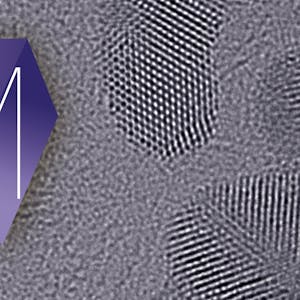Transmission electron microscopy for materials science
Learn about the fundamentals of transmission electron microscopy in materials sciences: you will be able to understand papers where TEM has been used and have the necessary theoretical basis for taking a practical training on the TEM.This course provides a comprehensive introduction to transmission electron microscopy (TEM) in the field of materials science. For an instrument operated by a single user, modern TEM provides an analytical platform with unsurpassed versatility, giving access to structural and chemical information from the micrometer to the sub-angstrom scale. In a thin, electron-transparent sample one can measure the crystallinity, grain structure, size, and defects, and the chemical composition. The crystal lattice can be imaged with atomic resolution, allowing observation of grain boundaries and interfaces. It is the only direct structural analysis method for studying nanoparticles.
With this course you will gain a deep understanding of modern TEM and the connection between:
- the optics and operation of the instrument;
- the physics of electron-matter interactions;
- insights into the materials properties of the sample.
This gives the background to:
- identify TEM techniques suitable to solving specific scientific problems;
- interpret TEM data presented in articles; appreciate the impact of technological advances that have, for instance, led to sub-angstrom resolution by aberration correction.
It can also be the basis for subsequent practical training on this remarkable instrument, and a stepping stone towards learning very advanced techniques with magical names like “dark field holography” or “angular resolved electron energy-loss spectroscopy”.
Recommended background:
Basics of crystallography and diffraction, college optics (construction of ray diagrams) are absolutely mandatory prerequisites; Fourier optics, more advanced crystallography and solid state physics are of great advantage.
You will be able to understand papers where TEM has been used and have the necessary theoretical basis for taking a practical training on the TEM.
Syllabus
Syllabus - What you will learn from this course
Week 1
Introduction
Week 2
Introduction (II)
Week 3
Diffraction basics (I): Ewald sphere / Reciprocal lattice
Week 4
Diffraction basics (II): Multi-beam / Kinematical scattering
Week 5
Diffraction and imaging: Dynamical effects (I)
Week 6
Diffraction and imaging: Dynamical effects (II)
Week 7
Phase contrast (I)
Week 8
Phase contrast (II)
FAQ
When will I have access to the lectures and assignments?
Access to lectures and assignments depends on your type of enrollment. If you take a course in audit mode, you will be able to see most course materials for free. To access graded assignments and to earn a Certificate, you will need to purchase the Certificate experience, during or after your audit. If you don't see the audit option:
What will I get if I purchase the Certificate?
When you purchase a Certificate you get access to all course materials, including graded assignments. Upon completing the course, your electronic Certificate will be added to your Accomplishments page - from there, you can print your Certificate or add it to your LinkedIn profile. If you only want to read and view the course content, you can audit the course for free.
Is financial aid available?
Yes. In select learning programs, you can apply for financial aid or a scholarship if you can’t afford the enrollment fee. If fin aid or scholarship is available for your learning program selection, you’ll find a link to apply on the description page.
Reviews
It really help me a lot understanding the basic principles of TEM. It is really useful if you are immersed in the materials science field. Thank you!
not an "easy A"
i had to work very hard to successfully complete this course
but i feel rewarded b/c of it to earn the certificate
Extremely useful and very interesting! Very well explained and detailed course!
Excellent course for understanding TEM from all points of view, with applied examples and research -derived problems for assignments.
